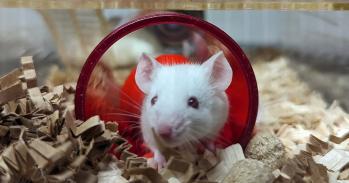
Although our brains deteriorate as we get older, Cambridge researchers are finding that some abilities are preserved through ‘flexible’ use of neural networks.
Although our brains deteriorate as we get older, Cambridge researchers are finding that some abilities are preserved through ‘flexible’ use of neural networks.
They focus on one aspect of brain function – language – and use behavioural testing and neuroimaging to monitor the different patterns of change that occur with age.
The brain – the most complex organ in the human body – comprises billions of nerve cells, each forming the myriad of connections needed for cognitive functions. Inevitably, as our body ages, so does our brain, placing a burden on these abilities. But, compared with the dramatic effects of grey matter damage caused by accident and stroke, age-related neural degeneration, or atrophy, does not have uniform effects on older adults’ cognition. Instead, current research shows that although old age is associated with deficits in some functions, other abilities are not affected.
In the Centre for Speech, Language and the Brain (CSLB) in the Department of Experimental Psychology, researchers are working to understand the relationship between neural ageing and cognitive ageing. They focus on one aspect of brain function – language – and use behavioural testing and neuroimaging to monitor the different patterns of change that occur with age. Some language abilities show dramatic declines, like word finding, yet others are maintained across the lifespan, like sentence comprehension. Research from the CSLB indicates that, although decline may be due to neural atrophy, in some cases older adults can maintain performance by effectively and flexibly using the neural resources they still have.
It’s on the tip of my...?
One of the most irritating and troubling difficulties reported by older adults is an increase in word-finding problems, known as tip-of-the-tongue states (TOTs). Although people of all ages occasionally experience the frustration of being temporarily unable to produce a well-known word or a person’s name, TOTs become more common with advancing age. This is a source of concern for many older adults, who worry that this type of forgetfulness is a sign of serious memory problems or even encroaching dementia. But, despite the feeling during a TOT that your mind has gone completely blank, research indicates that a great deal of information is available about the word you are searching for; all that is missing is the actual sound.
Neuroimaging can be used to understand why TOTs are more common in old age. In the CSLB, a recent research project recruited volunteers aged 19 to 88 years to perform a task in which they named pictures of celebrities whose names had been selected as being vulnerable to TOTs. In the same study, a magnetic resonance imaging (MRI) brain scan was carried out to visualise the extent of age-related changes to grey and white matter. As expected, the rate of TOTs increased with age, but what was interesting was that this increase was related to decreased grey matter in regions of the brain that are important for retrieving the sounds of words.
Delving deeper into the source of the problem, functional MRI was used to examine neural activity while the participants actually performed a TOT task. Younger adults, who typically have fewer TOTs, generated a ‘boost’ of activity during a TOT compared with during successful naming, again in brain regions important for sound retrieval. Tellingly, older adults, who typically have more TOTs, were less able to generate this boost of activity, showing a clear link between increased TOTs and reduced neural activity in critical regions.
It’s not all downhill
Although the link between increasing atrophy and declining performance seems straightforward, it is important to remember that cognitive deficits in old age are not simple, uniform, or even absolute. Although older adults have problems producing words, they are generally as good as younger adults at tasks involving comprehending language.
By testing young, older (aged 49–68 years) and ‘very’ old (over 70 years) volunteers for their ability to listen to and comprehend sentences, some interesting findings came to light in the CSLB. Older and very old adults showed significant grey matter atrophy compared with younger adults, but only the very old were slowed down – the older adults under 70 years old were just as fast as younger adults, despite deterioration in brain regions important for language comprehension.
How did older adults maintain their performance, and why did the very old adults not? This was examined by recording neural activity during a more difficult sentence comprehension task, where the sentence contained an ambiguous phrase that is more difficult to comprehend (e.g. ‘private coaches’, which might refer to tour buses or personal trainers). This is true even when the sentence context tells you which meaning is appropriate, as in: ‘Although they are expensive, private coaches teach children effectively.’
Compared with hearing sentences that did not contain ambiguous phrases, hearing sentences with ambiguous phrases leads younger adults to activate regions in the left hemisphere of the brain that are known to be important for understanding language. Older adults also activated these regions, plus additional regions in the right hemisphere, raising the interesting possibility that the recruitment of the right hemisphere regions is what enables older adults to maintain their performance. However, very old adults, who respond more slowly, activated only the same left hemisphere regions as the younger adults. Why didn’t the oldest adults recruit their right hemispheres? This is an ongoing area of study but one possibility is that continued deterioration in grey matter in very old age limits the ability of individuals to flexibly recruit neural regions when they are needed.
Preserving performance
These findings imply that although you can’t prevent increasing brain deterioration with age, performance may be preserved when neural flexibility is possible. This may be true even for TOTs: despite the fact that TOTs are frustrating and potentially embarrassing, they are temporary problems, and often resolve themselves spontaneously. In the laboratory, TOTs can be overcome by cueing participants with key sounds in the target word. This intervention is limited to a laboratory environment but it makes the important point that TOTs are not permanent or static, and may even be avoidable under some circumstances. Finally, although older adults as a group suffer more TOTs, some individual older adults generate as few TOTs as their younger counterparts, raising the possibility that some older adults may be able to avoid even the most common cognitive changes in old age.
How can we best maintain our cognitive health in old age? Can we encourage neural flexibility? This research does not yet point to any clear interventions, but adds to growing evidence that old age doesn’t lead to universal or inevitable cognitive decline. Understanding the conditions in which older adults can make the best use of the neural flexibility they still have will be an important step forward.
For more information, please contact the authors Dr Meredith Shafto (mshafto@csl.psychol.cam.ac.uk) and Professor Lorraine K Tyler (lktyler@csl.psychol.cam.ac.uk) in the Centre for Speech, Language and the Brain at the Department of Experimental Psychology.
This work is licensed under a Creative Commons Licence. If you use this content on your site please link back to this page.





